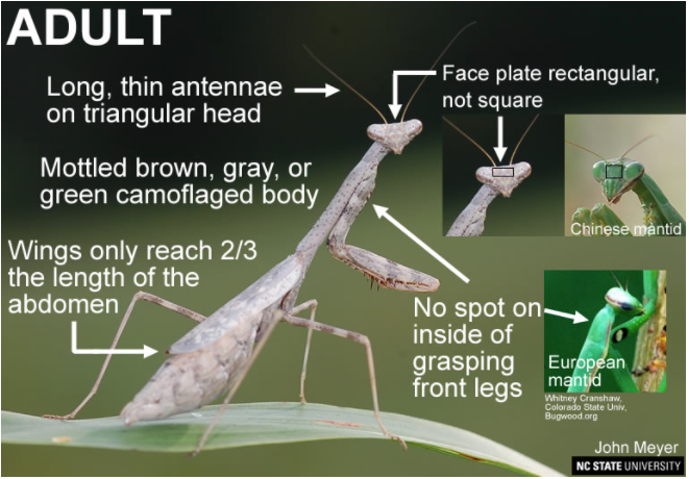Praying Mantis – Garden Hunters
go.ncsu.edu/readext?824256
en Español / em Português
El inglés es el idioma de control de esta página. En la medida en que haya algún conflicto entre la traducción al inglés y la traducción, el inglés prevalece.
Al hacer clic en el enlace de traducción se activa un servicio de traducción gratuito para convertir la página al español. Al igual que con cualquier traducción por Internet, la conversión no es sensible al contexto y puede que no traduzca el texto en su significado original. NC State Extension no garantiza la exactitud del texto traducido. Por favor, tenga en cuenta que algunas aplicaciones y/o servicios pueden no funcionar como se espera cuando se traducen.
Português
Inglês é o idioma de controle desta página. Na medida que haja algum conflito entre o texto original em Inglês e a tradução, o Inglês prevalece.
Ao clicar no link de tradução, um serviço gratuito de tradução será ativado para converter a página para o Português. Como em qualquer tradução pela internet, a conversão não é sensivel ao contexto e pode não ocorrer a tradução para o significado orginal. O serviço de Extensão da Carolina do Norte (NC State Extension) não garante a exatidão do texto traduzido. Por favor, observe que algumas funções ou serviços podem não funcionar como esperado após a tradução.
English
English is the controlling language of this page. To the extent there is any conflict between the English text and the translation, English controls.
Clicking on the translation link activates a free translation service to convert the page to Spanish. As with any Internet translation, the conversion is not context-sensitive and may not translate the text to its original meaning. NC State Extension does not guarantee the accuracy of the translated text. Please note that some applications and/or services may not function as expected when translated.
Collapse ▲Mantids are ambush predators, the hunting cats of the insect world that sit and wait, surveying their surroundings for a potential meal. Their camouflage disguises resembling leaves and sticks are the perfect adaptation to hunting in the garden verge. Huge compound eyes contain 10,000 light receptors in each one constructed with two lenses and are capable of seeing images and colors. Mantids have an elongated thorax that functions like a neck, enabling the triangular head to turn almost 360 degrees.
As generalist predators they attack and seize their unwary insect (and sometimes other small arthropods) prey with raptor-like front legs armed with spines to pin their quarry while their powerful mandible mouthparts devour it. As a large predatory insect they eat any meal they can catch, beneficial or otherwise, however mantids do not bite humans.
Females are known to kill and consume males after or during mating, perhaps for an extra caloric energy boost before laying eggs. Females are able to produce more eggs after this large meal and the males die soon after mating regardless.
Three species of mantids are found in North Carolina. Both the European mantid (Mantis religiosa) and Chinese mantid (Tenodera sinensis) were introduced into the United States in the late 1800s. The Carolina mantid (Stagmomantis carolina) is native to the United States and found from New York south to Florida and west to Utah, Arizona, and Texas. The Carolina mantid is easily distinguished from the other species as it is about 2 inches smaller as an adult, has shorter wings and a rectangular faceplate between the eyes rather than the square found in the other species.
native to the United States and found from New York south to Florida and west to Utah, Arizona, and Texas. The Carolina mantid is easily distinguished from the other species as it is about 2 inches smaller as an adult, has shorter wings and a rectangular faceplate between the eyes rather than the square found in the other species.
While many folks find insects, well…kind of creepy, if viewed as animals in our ecosystem we can better understand the connections and continuity between us. Time outdoors, in our gardens and other greenspaces, spent observing these animals with patience and focus leads to an understanding and love of nature and hopefully an appreciation of the many small worlds within the bigger world that we steward.
Minda Daughtry is the Horticulture Agent for North Carolina Cooperative Extension in Lee County.




